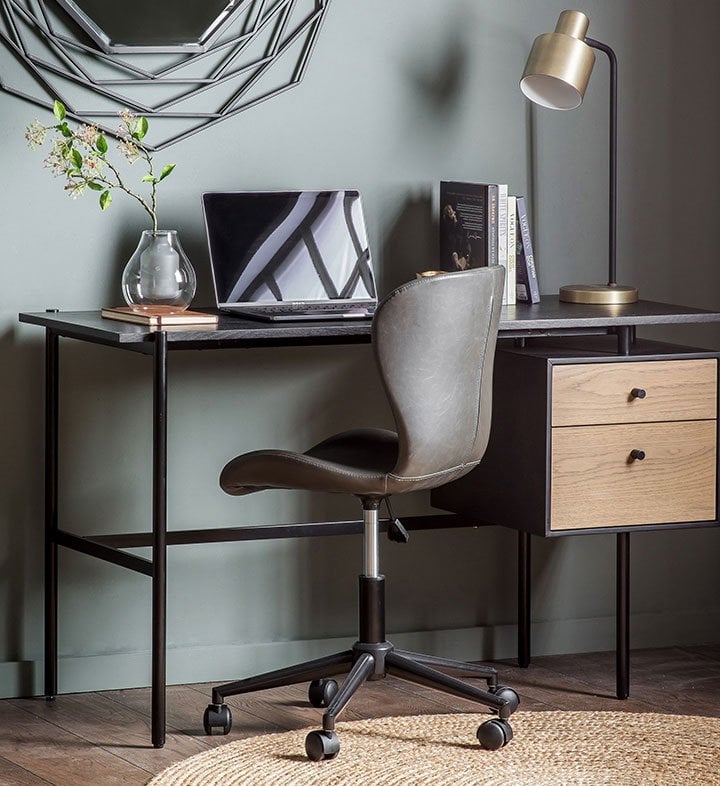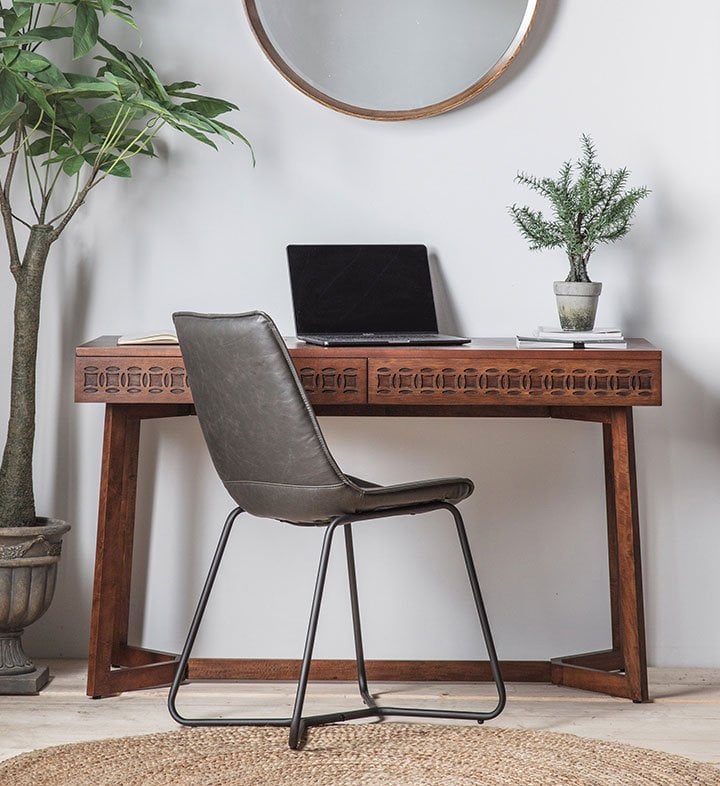How to Create an Ideal Workspace from Home


Working from home has become a regularity for many over the past couple of years largely due to the recent global pandemic. For employees and employers alike, working remotely has plenty of positives but also some drawbacks. Examining what works effectively and what isn’t so productive allows you to build an ideal work environment that suits your specific needs. Having a setup that is suitably thought out provides an employee with the best chance to produce the most effective work possible . There are plenty of benefits to working from home, both for the employer and employee. Being flexible and working together to discover the best possible set up can allow you to compose a space that you’re most productive in.
Setup a Space Designed for Productivity
The most important aspect to consider when creating a workspace in your home is how to increase or maintain your productivity levels . Productivity doesn’t specifically mean the time spent on a task. It instead focuses on the effectiveness of your working, ensuring you’re recharging and recalibrating at suitable intervals . Making sure you’re organised can vary from having a work planner on Excel to implementing a drawer organiser that neatly stores all your stationary. Being aware of where everything you’ll need is and having a plan of what you’re going to do for each day will make the working day a lot more polished, reducing the possibility of any unwanted stoppages.
Workplace ergonomics can be defined as the study of designing a workplace that improves work efficiency whilst reducing the possibility of injuries and accidents. Other benefits of workplace ergonomics include increased morale, bettering employee health and reduced absenteeism. There are plenty of methods to improve workspace ergonomics even down to little things that can end up making a big difference in your workplace. As an employee, some suggestions to improve your workplace ergonomics include having proper posture, taking scheduled breaks, changing the lighting, and having the optimum hardware equipment. Identify what you’ve already got at home and upgrade anything that you don’t believe is up to par. Focus on whether your desk chair provides enough lumbar support, your desk allows your computer or laptop to be eye level and if you’ve got sufficient lighting in the area.
It may sound obvious but having to continuously pause working to fix any issues with your set up will massively stunt productivity levels. You want to take breaks, of course, but they should be solely for recuperating and not stressing. A home office setup should contain all the resources required to complete your job, whether that be an online system or a camera on top of your monitor. Thoroughly checking that everything functions as it should, prevents the possibility of mishaps that temporarily halts your ability to work. Having a strong internet connection is a vital part of any home office with a wired ethernet cable proving the smartest option.
Building an environment that you enjoy being in and provides inspiration can add a more emotional connection to your work. Options include photos of loved ones, a plant you’re fond of, or ornaments that mean something to you. Implementing these around your workspace will improve your wellbeing and eagerness to work. However, you want to incorporate this in moderation otherwise it could become untidy and offer up too many distractions. Every employee differs considerably, meaning you should question what visually appeals to you that won’t become a distraction and work from there.

Communication is Crucial
Being absent from actual office life can be a challenge in many ways, but the most prominent problem is likely how you keep in touch with your co-workers. You’ll probably need to get in touch to solve any issues you or your colleagues have, brainstorm ideas, and just have non-work-related chats. It’s important that you don’t feel tentative when asking for help or putting ideas forward just because you’re not physically there. Establishing communication channels before the day begins allows the interactions to become coherent, almost like you’re there in person. An advantage when interacting in person is being able to view someone’s facial expressions and body language which helps improve your understanding of where they’re coming from. Video calls aside, this isn’t possible to do when working from home. In this case, your tone of voice or writing must be carefully thought out otherwise you run the risk of getting misunderstood.
Mastering both your written and verbal communication will help you to thrive in a home working environment, completing tasks efficiently and giving feedback when necessary. Learning when the best time to engage with your colleagues is and through what platform will differ depending on scenarios and the reason for getting in contact. For example, if you have a slight issue that isn’t urgent, an email might be best, whereas more pressing issues may require a phone call. Getting this right could take a couple of weeks but once you understand how to effectively communicate, you and your colleague’s job will become a lot easier. You can then create a plan that guides when and how you can best contact everyone.
Being unable to visibly see you, employers and employees alike can find it hard to trust that other colleagues are pulling their weight. You can put their minds at rest by giving regular updates of what you’re working on and set deadlines if there aren’t already. If you are managing a team, providing clear instructions with appropriately timed check-ups and a metaphorical open door ensures all employees are aware of what needs to be done and will meet the deadline
You should also take into consideration who else will be present in the house during your period of work. Informing your family members or housemates that you require an undisturbed environment in advance of your workday will allow you to operate in a seamlessly manor. Notifying them when you’ll be on your break so you can interact in a relaxed fashion is a great way of breaking up the day. Having that time to casually talk on non-work-related topics is vital, no matter whether that’s with a loved one or a colleague. It gives your hectic mind a breather which can then allow you to see things clearer when you return to your desk.

Structure your Day
As humans, we have an innate requirement for structure to be successful during work life. Working from home can lead to many either creating sub-par schedules or not creating one at all, which can be extremely damaging to how effective you are whilst working. If you aren’t given working hours to follow, it is important that you create a sensible one for yourself, effectively communicating this with the appropriate people so they are aware of when to contact you. If your schedule is changing every day, it can be difficult to find a mental and physical rhythm whilst you’re working. There is a common association between working from home and staying in your pyjamas that, whilst it might sound idealistic, can stunt your effectiveness. Establishing a morning routine that isn’t too dissimilar from one you would have if you were going into the office can help you get mentally ready for your day of work ahead.
Structuring your actual work shouldn’t be too unlike how you would plan your daily tasks whilst at the office, with a few things to keep in mind. Scheduling time slots to communicate with your colleagues, whether that be providing or receiving information, is vital in ensuring everyone is on the same page and knows what’s required of them. Giving specific time slots to your colleagues as to when you will be contacting them allows them as well as yourself to structure your day easier as no one gets unexpectedly interrupted. As important as it is to be fully focused on your workload, it is just as crucial to take breaks and with no co-workers to follow, this can often be neglected. Setting alarms for breaks is an effective way of reminding yourself to take that necessary time away from your screen. Once you leave your workspace, you should stretch your legs, speak to loved ones, and most pertinently take your mind off work. Once you do this and then return to work, you’ll find yourself a lot more productive than if you would’ve skipped the break.
Since you can’t physically leave work to go home, making sure you have a finish time where you wrap things up for the day is essential. There can be a tendency to feel like there’s still more to do and continue working until you burn out. Doing this once, let alone regularly, can have a detrimental effect on your mental wellbeing and motivation to work in the future . Be strict with yourself and abide by your cut-off points to ensure you can maintain a positive mindset and complete work to the best of your ability. It can sometimes be difficult for managers to praise your work whilst you’re are miles apart. As much as you hope they keep up with the work you’re producing, it is important to regularly congratulate yourself when you get a lengthy task completed. This will help you to stay motivated and avoid dropping to a mediocre level.

Master your Mindset
Whilst the tasks you complete may be the same, working from home is an entirely different environment compared to the office, and therefore requires a distinct mindset to go along with it. When you see other colleagues working, it sub-consciously motivates and influences you to get your head down and work harder. Without this, and the pressure of your boss looking over your shoulder, it can be difficult to work as efficiently as you would do within an office scenario. Similar to when you’re structuring your day, you require a reasonable amount more self-discipline and commitment compared to being in the office. Sticking to your routine daily allows you to maintain a productive work from home life on a regular basis and stepping out of this framework too far can be detrimental. As previously mentioned, taking breaks, and communicating with those away from the work environment is essential in functioning as effectively as possible. Escaping and taking your mind off the daily stress of work tasks is a great breather for your brain that will impact on how well you work once you return.
Your surroundings play a massive part in how you perform whilst working from home. There is a lot to consider and as everyone’s mind works differently it allows you to personalise your set up, creating a space that works well for your specific needs . As briefly mentioned earlier, removing distractions is something that everyone can relate to. You know best what non-work-related things are likely to capture your attention, so it is wise to confiscate these from yourselves, allowing you to remain focused. When it comes to the overall set-up, it can help to invest in similar equipment and furniture that you would find in your office. However, you don’t want it to feel dull and lacking personality, so include elements that appeal to your visual preference such as a poster on your wall or ornaments on your desk. It’s about finding that balance between forming a unique space that embodies your personality and building a work environment that you can thrive in. Most importantly ensure you have a tidy and comfortable place that you look forward to spending long periods of time in.
Becoming aware of our individual self-talk language can help us to control it and provide a better mental state daily. The messages you are internally telling yourself will have a massive impact on how your mindset is, and if not positive can leave you dreading the day and producing an inadequate standard of work. This often starts in the morning when you have the day ahead of you and aren’t looking forward to your workload. It might be difficult in some scenarios but challenging yourself to have a positive mindset and outlook on every situation can boost your wellbeing and improve your level of performance. Look for the positives and don’t be too hard on yourself when working alone. In fact, do the opposite and be extra kind to yourself, praising yourself in place of your distant boss and colleagues. Obviously, self-praise must be justified and only you can know if you’ve done something to the best of your abilities or just winged it. Focusing on how you approach working from home can be key in determining the feeling towards your job as well as the quality of your tasks.

To Conclude
There’s no denying that many elements go into constructing a home workspace that’s just as productive as an office scenario would be. It’s unlikely that you will get it completely right on your first attempt, but this isn’t necessarily a negative. If you can retrospectively observe any flaws and make calculated changes, then it will massively help. Whilst there is no direct formula to follow, there are plenty of quick and easy alterations that will transform your space and make it a more enjoyable working environment . Working from home allows you to spend more time with loved ones as well as saving money on commuting, so if you’re given the opportunity to do so then give it a go. Take on board advice from your manager, people who are currently partaking, and this blog to ensure you have every possibility to work at to your best ability. It’s not as difficult as some people may think, with the most important thing to focus on what helps you work best, whilst remaining conscious of your own wellbeing.
